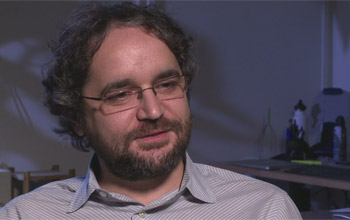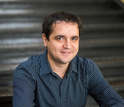News Release 16-041
Materials research earns chemistry professor 40th annual Alan T. Waterman Award
MIT's Mircea Dincã develops hybrid microporous materials with unprecedented electrical conductivity
April 14, 2016
This material is available primarily for archival purposes. Telephone numbers or other contact information may be out of date; please see current contact information at media contacts.
On the 40th anniversary of the Alan T. Waterman Award, the National Science Foundation (NSF) selects MIT chemistry professor Mircea Dincã as its 2016 winner.
"It's a pleasure to recognize Dr. Dincã as this year's recipient of the Alan T. Waterman Award," said NSF Director France Córdova. "His research in microporous solids is revolutionizing how scientists approach this exciting new technology, opening the door for future discoveries."
Congress established the Alan T. Waterman Award in 1975 to recognize outstanding young scientists whose accomplishments showed exceptional promise of significant future achievement. Candidates may not be more than 35 years old, or seven years beyond receiving a doctorate degree.
During the past 40 years, the award has been used by winners to document the earliest history of life on Earth, to find earthlike planets outside our solar system and even discover ways to build replaceable body parts for people suffering chronic conditions.
Dincã's research demonstrated metal organic frameworks (MOF) can store electrical energy -- something previously unknown -- resulting in a new class of MOF materials with high surface areas possessing "charge mobility values." One day, they may be used in electrocatalysis for renewable energy applications, such as carbon dioxide and oxygen reduction in fuel cells or electric vehicle fuel storage.
MOFs are materials with microscopic pores that act like sponges and can absorb or pick up various molecules and ions. These properties make them useful for gas and vapor separation, drug storage and delivery, plus any number of other applications. In the past 15 years, more than 20,000 MOFs have been reported and studied.
Dincã's research focuses on using organic and inorganic materials to develop new, hybrid MOFs with unprecedented electrical conductivity. Electrical conductivity in MOFs is potentially useful to make high-powered super capacitors that store power for both novel and anticipated uses like renewable batteries in cell phones.
He and his team also focus on giving MOFs redox activity. This imparts important functionality to a material, allowing it to not only selectively absorb molecules into its dynamic framework, but change them chemically through controlled catalysis.
In addition to the Alan T. Waterman medal, Dincã will receive a grant of $1 million over a five-year period for scientific research or advanced study in any field.
Dincã says he has no predetermined goals for the next phases of his research, but he's looking to explore areas of research he described as "a little bit unknown to us."
"I think if you go into something with a little bit of ignorance, into a new field, you can discover new, interesting things," he said.
Last year, NSF's Division of Materials Research in the Directorate for Mathematical and Physical Sciences awarded Dincã a CAREER grant for studies of small molecule reactivity in redox-active MOF materials.
-NSF-
-
MIT chemistry professor, Mircea Dincă, is 40th annual Alan T. Waterman Award winner.
Credit and Larger Version
Media Contacts
Bobbie Mixon, NSF, (703) 292-8070, email: bmixon@nsf.gov
The U.S. National Science Foundation propels the nation forward by advancing fundamental research in all fields of science and engineering. NSF supports research and people by providing facilities, instruments and funding to support their ingenuity and sustain the U.S. as a global leader in research and innovation. With a fiscal year 2023 budget of $9.5 billion, NSF funds reach all 50 states through grants to nearly 2,000 colleges, universities and institutions. Each year, NSF receives more than 40,000 competitive proposals and makes about 11,000 new awards. Those awards include support for cooperative research with industry, Arctic and Antarctic research and operations, and U.S. participation in international scientific efforts.
Connect with us online
NSF website: nsf.gov
NSF News: nsf.gov/news
For News Media: nsf.gov/news/newsroom
Statistics: nsf.gov/statistics/
Awards database: nsf.gov/awardsearch/
Follow us on social
Twitter: twitter.com/NSF
Facebook: facebook.com/US.NSF
Instagram: instagram.com/nsfgov




